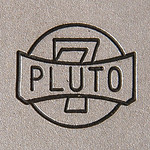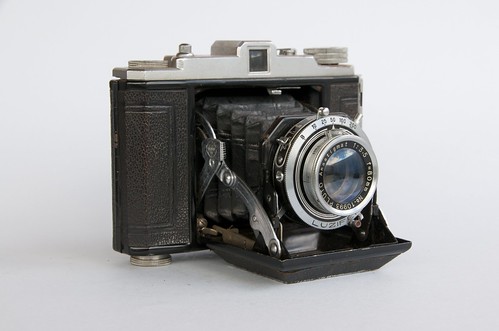Pluto Six
The Pluto Six (プラトーシックス) are Japanese 6×6 folders made in 1955 by Shichiyō Kōgaku Kōgyō and distributed by Pluto Shōkai.

|
| image by Geoff Harrisson (Image rights) |
Contents
Common features
The Pluto Six are horizontally folding cameras, with curved three-part struts. The film is advanced by a knob at the left end of the top plate, as seen by the photographer. There is a decorative flange at the opposite end, and the shutter release is at its usual location on the right. The back is hinged to the right and contains two red windows placed one above the other, protected by horizontally sliding individual covers. The upper red window is for 4.5×6cm exposures and the middle one is for 6×6cm; the covers are accordingly inscribed 4.5X6 and 6X6. The camera has hinged masks in the exposure chamber for 4.5×6cm exposures, the optical finder has two lines to show that format.
The name "Pluto Six" is embossed in the leather covering at the rear. A Pluto 7 logo is embossed in the leather of the front door, engraved on the top plate and in the folding struts, and embossed at the front of the leather case. The number "7" is certainly an allusion to the company name Shichiyō (七洋): shichi means "seven" in Japanese.
All the models have an 80mm f/3.5 lens. The shutter is always synchronized for flash and equipped with a self-timer.
Original documents
The Pluto Six models were advertised from January to May 1955, and were featured in the March 1955 issue of Sankei Camera.[1] The advertisement reproduced below was placed in the January to March issues of Asahi Camera.[2] It lists two models: the Pluto Six P with uncoupled rangefinder and B, 1–200 speeds, priced at ¥9,400, and the Pluto Six L with B, 10–200 speeds, priced at ¥6,900 (case included). The document mentions the manufacturer Shichiyō Kōgaku Kōgyō and the distributor Pluto Shōkai.

|
| Advertisement for the Pluto Six in Asahi Camera, January to March 1955. (Image rights) |
The May 1955 advertisement in Sankei Camera lists the Pluto Six P at an unchanged price, along with the Stereo Pluto stereo camera.[3]
The Pluto Six L

|
| Rear of Pluto Six L, with embossed name image by Dirk HR Spennemann (Image rights) |
The Pluto Six L only has a viewfinder, integrated in the middle of the top housing. The accessory shoe and folding bed release are offset to the left.
One presumably early example is pictured in Sugiyama with a no-name shutter (B, 1–200, self-timer), synchronized via a PC socket at the bottom.[4] The lens is a Pluto 80mm f/3.5 with a silver bezel. Its serial number (no.8289) probably indicates that this camera is earlier than those described below.
Other examples differ from the above one by minor details: the top housing has sharper edges, the advance knob and decorative flange at the top are slightly different. They have a Luzifer shutter (B, 10–200, self-timer), synchronized via an ASA bayonet post or a PC socket.[5] The shutter plate has an S logo on the side, repeated above the shutter casing next to the synch post, and the name LUZIFER is engraved at the bottom of the shutter rim. The lens is a Pluto Anastigmat 80mm f/3.5 with a black bezel, and known lens numbers are in the 10xxx–12xxx range.[6]
The Pluto Six P

|
| Pluto Six P image by Geoff Harrisson (Image rights) |
The Pluto Six P has an uncoupled rangefinder, combined into the viewfinder. The common eyepiece is offset to the right, as seen by the photographer. The rangefinder is driven by a wheel falling under the left thumb. The accessory shoe and folding bed release are placed above the second image window, very slightly offset to the left.
Various surviving examples are known.[7] All of them have a Luzifer shutter (B, 1–200, self-timer) with a PC socket. The shutter markings are the same as described for the Pluto Six L. The lens is a Pluto Anastigmat 80mm f/3.5 with a black bezel, and the known body numbers are in the 50xxx and 52xxx range.
Notes
- ↑ Kokusan kamera no rekishi, p.362.
- ↑ Advertisement in Asahi Camera January 1955, p.232, February 1955, p.201, and March 1955, p.209.
- ↑ Advertisement reproduced in Kokusan kamera no rekishi, p.173.
- ↑ Example pictured in Sugiyama, item 1402, where it is called "Pluto Six L (DX)" for an unknown reason.
- ↑ ASA post: example pictured in Sugiyama, item 1401. PC socket: example pictured in McKeown, p.890.
- ↑ No.10993: pictured above; no.12070: example pictured in McKeown, p.890; no.12138: example pictured in Sugiyama, item 1401.
- ↑ Example pictured in Sugiyama, item 1403, and examples observed in online auctions.
Bibliography
Original documents
- Asahi Camera. Advertisements by Shichiyō Kōgaku Kōgyō and Pluto Shōkai:
- January 1955, p.232;
- February 1955, p.201;
- March 1955, p.209.
Recent sources
- Asahi Camera (アサヒカメラ) editorial staff. Shōwa 10–40nen kōkoku ni miru kokusan kamera no rekishi (昭和10–40年広告にみる国産カメラの歴史, Japanese camera history as seen in advertisements, 1935–1965). Tokyo: Asahi Shinbunsha, 1994. ISBN 4-02-330312-7. Item 776.
- Lewis, Gordon, ed. The History of the Japanese Camera. Rochester, N.Y.: George Eastman House, International Museum of Photography & Film, 1991. ISBN 0-935398-17-1 (paper), 0-935398-16-3 (hard). P.86 (brief mention only, the camera is called Plato Six by mistake).
- McKeown, James M. and Joan C. McKeown's Price Guide to Antique and Classic Cameras, 12th Edition, 2005-2006. USA, Centennial Photo Service, 2004. ISBN 0-931838-40-1 (hardcover). ISBN 0-931838-41-X (softcover). P.890.
- Sugiyama, Kōichi (杉山浩一); Naoi, Hiroaki (直井浩明); Bullock, John R. The Collector's Guide to Japanese Cameras. 国産カメラ図鑑 (Kokusan kamera zukan). Tokyo: Asahi Sonorama, 1985. ISBN 4-257-03187-5. Items 1401–3.
